Introduction of an Infrastructure Charging Mechanism in Scotland: research project
This research focuses on the options for an infrastructure charging mechanism.
4 Methodology for Assessment
4.1 Introduction
This section sets out the methodology developed to further assess and shortlist the high level options that emerged from the Stage 1 and Stage 2 research.
This section first sets out the key criteria by theme identified through the Stage 1 and 2 research. This has been informed by the project brief, workshops, consultations and secondary research. The basis of these criteria have been set out in the introduction. Secondly, this section sets out the options emerging from the Stage 1 & 2 research, which resulted from an initial assessment of high level options.
The assessment comes in the form of two interrelated sets of criteria:
1.Final Priorities ( Section 4.5); and
2.Central Assessment Criteria ( Section 4.6).
The options presented in Chapter 6 are reassessed against these criteria in Section 7.1.
Final Priorities
The high level options considered in Stage 1 and Stage 2 are brought forward and elaborated upon. Further principles which have emerged from the Planning Review consultation are considered against the key criteria which formed the initial assessment of high level options in Stage 1 and Stage 2. The principles drawn from the Planning Review Consultation have been further assessed by members of the project team with representatives from the Scottish Futures Trust and Scottish Government to progress the shortlisting of the high level options. This informed the ‘Final Priorities’ set out in Section 4.4.
Central Assessment Criteria
The second aspect of the assessment is setting out the ‘Central Assessment Criteria’ which inform the robust understanding of costs, benefits, risks and uncertainties arising from the development and implementation of changes in policy. [2] The Central Assessment Criteria follow best practice and are arranged by the following areas:
- Setting Objectives, Outputs and outcomes;
- Measuring Costs and Benefits;
- Adjusting for market changes (cost adjustment); and
- Accounting for Risk and Uncertainty.
The ‘key priorities’ have been iteratively and robustly developed and serve as ‘Objectives and Outcomes’ as part of the ‘Central Assessment Criteria’ against which to test the Preferred Options.
The option assessment process is set out diagrammatically in Figure 4.1.
Figure 4.1 Options Assessment Process
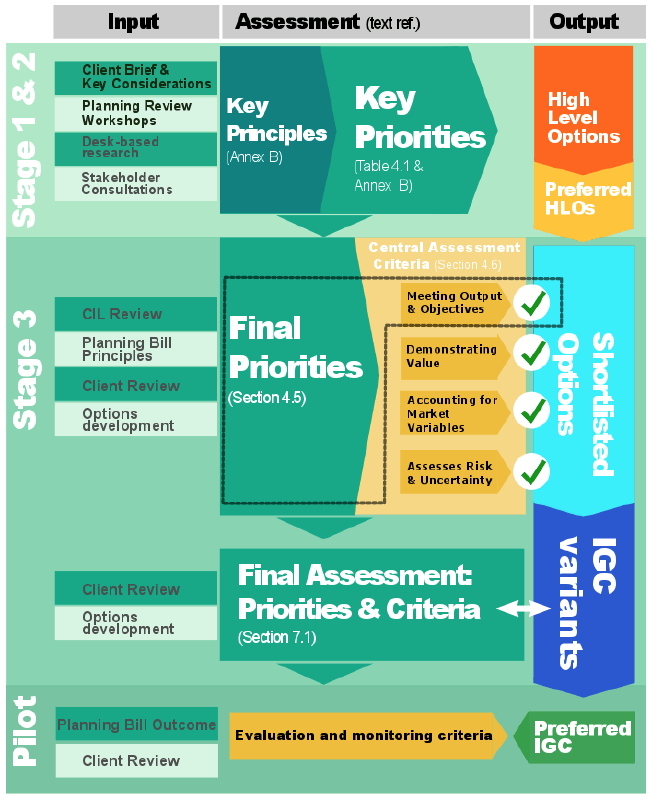
4.2 Stage 1 & 2 ‘Key Priorities’
Stage 1 and 2 of this research set out key principles governing the development of the proposed infrastructure levy. These were drawn from initial Scottish Government Workshops, research consultations and stakeholder engagements, and consideration of best practice through the United Kingdom. At Stage 1 and Stage 2, they provided broad guiding positions on the purpose, scope and operation of the charge.
Furthermore, the Priorities were grouped according to key principles which are similarly drawn from consultations but equally informed by existing policy guidance with respect to developer contributions. [3]
These principles serve as a starting point for the determination of High Level Options ( HLOs), and have informed the testing and development of the Shortlisted Options.
Table 4‑1 Key Principles & Priorities
| Policy Theme | Priorities |
|---|---|
| Fairness |
|
| Transparency |
|
| Certainty |
|
| Efficiency |
|
4.3 Emerging Options from Stages 1 & 2
Stages 1 & 2 of this research identified a series of options based on existing and potential administrative geographies and on the mechanisms required for collecting the levy. ‘High Level Options’ ( HLOs) were considered in terms of geography, mechanisms, funds and purpose of the infrastructure funds. This stage of the research assessed the following options:
Table 4‑2 Emerging Options
| Geography: | Mechanism |
|
|
| Funding model | Purpose |
|
|
Geography was identified as a complex component of the charge, particularly in reflecting administrative geographies, forms of governance and market variations within areas covered by a charge. Consultations and a review of combinations of options against key priorities suggested that geographies ought to be flexibly defined to account for changing market conditions and scale of infrastructure requirements.
The brief assessments in Stages 1 and 2 suggest that existing administrative geographies (e.g. planning authorities, strategic development planning authorities or partnership bodies like City Deals) may have processes in place to implement a charge-type mechanism, but these boundaries may not be reflective of a functional market area, nor do the resources within the authorities exist to adequately assess the viability of a charge or the deliverability of infrastructure projects. This has a concomitant effect on how, as suggested in the stakeholder workshops, the mechanisms may be integrated with development plans. The means by which local authorities work together to effectively identify infrastructure required to deliver development, therefore depends on an effective understanding of the management structures behind the scheme.
As noted, an organisation such as the Scottish Futures Trust ( SFT) may have resources and expertise that could be used to help administer the scheme. But it also needs to be decided how the application of the scheme is coordinated with existing administrative structures.
Considering the assessment set out in previous stages of the research, a preferred set of options was identified which most closely fit the criteria set out above:
Geography
- Local authority;
- City Region Deals, or other forms of growth areas of combined authorities or regional partnerships; or
- The above combined with a national charge.
Mechanism
- A charge based on quantum of development output; or
- A charge based on the value of development output.
In line with these conclusions and in line with the criteria set out above, Stage 1 and 2 set out ten scenarios based on an objective scoring methodology (set out in the Stage 1 & Stage 2 Report). There was a clear preference for market/growth areas and combined authorities or agencies in administering the charge. This stage of the assessment did not elaborate on the mechanics of the charge, though the assessment noted the preference in most instances for combined authority areas, such as City Deal areas and delivered by ‘greater than local’ authorities.
4.4 Scottish Government Consultation: Proposal 14 Principles
The Key Principles identified in Stage 1 and Stage 2 of the research, while informing the consultation process, needs to be re-assessed against the principles proposed in the consultation paper, “Place, People, Planning”. This will ensure consistency in proposals underway and the development of the levy in this Stage.
The Scottish Government released a consultation into the review of the planning system in 2017. Proposal 14 set out key principles including the following:
- It should be applied to most development types, with some potential exemptions;
- Permission to adopt and put in place a charging mechanism is granted by Ministers based on the submission of a business case prepared by the planning authority/authorities;
- The income from the charge should be collected locally;
- The fund will not replace national level infrastructure investment, as defined in the Infrastructure Investment Plan and National Planning Framework ( NPF); and
- The fund will not replace site specific contributions which are needed to mitigate the impacts of individual developments not covered by the levy and secured through Section 75 planning obligations or other methods.
These have been consulted upon with relevant stakeholders [4] and considered in light of the development of the preferred high-level options. The principles are considered qualitatively below and are incorporated into the assessment criteria set out in Table 4.3. Whilst this option development is considered against these principles, it is subject to change pending outcomes of the current consultation. Generally speaking, the principles identified in the consultation can be grouped under the Key Principles emerging from Stage 1 & Stage 2.
The Consultation Principles are considered below:
“It should be applied to most development types, with some potential exemptions”
A clear principle emerging from Stage 1 & Stage 2 and subsequent consultations is that there should be clarity around what is being funded by an infrastructure levy and which developments are required to pay. Evidence provided by the CIL suggests benefits to a charge that applies to all (or most) developments (according to unambiguous criteria), and that is flexible in meeting strategic infrastructure requirements.
The ‘strategic’ purpose of the fund emphasised in Stage 1 & Stage 2 research means that most development types could be eligible to pay. However, the relatively small receipts that are likely to be made available through the fund suggests that the ability of the mechanism to contribute to significant and costly infrastructure items is likely to be limited. It is nonetheless important that the use of the funds is justified on the basis that it addresses wider strategic needs (e.g. provision of education, green infrastructure, loan capital for other strategic projects). By addressing wider strategic needs of a geographical or market area, the application of the fund to most development types would be justified. A framework may be required to guide the administering body in how projects are identified for funding.
The issue of exemptions to a charge was identified in consultations in Stage 1 and Stage 2 and in subsequent consultations. Indeed, there are instances where a charge may not be applicable—there is precedent in the operation of CIL where there are exemptions for certain development types, which may be due to resourcing issues or viability. However, the more successful instances of the Levy in England are applied generally, but at a low level (e.g. London Mayoral CIL). On this basis, it is considered that the baseline position ought to be to assume that most developments should contribute to the levy to avoid the administrative burden and potential avoidance. This may also mean that local authority/combined authority discretion is limited.
Details on what form of infrastructure it should support remains relatively open—some disagreement during Stage 1 and Stage 2 suggests that the ‘definition’ of infrastructure may prove problematic. There is general agreement that “additionality” and “future growth” should be the main determinant of the project’s impact. Given the importance of addressing more strategic items of infrastructure, rather than individually negotiated sums with respect to specific sites, the system needs to be simple and flexible, potentially determined by a formula at a national level. The remit for charge setting would therefore not be incumbent on the local authorities or strategic authority.
“Permission to adopt and put in place a charging mechanism is granted by Ministers based on the submission of a business case prepared by the planning authority/authorities”
The principle of oversight is crucial for the smooth and effective operation of an infrastructure charging mechanism. The submission of a ‘business case’ was not explicitly considered in Phase 1 and Phase 2 research. However, there was clear preference for all infrastructure to be aligned to a plan, and being costed, deliverable with realistic funding mechanisms in place. The submission of a business case would add weight to these plans, undergoing necessary scrutiny to ensure delivery.
In practice it may be that local authorities or a regional body (e.g. City Deal bodies, on behalf of local authorities) prepare a business case for a mechanism. This may take the form of or supplement a regional ‘infrastructure plan’ or local development plan. Stage 1 and Stage 2 research concluded that a body such as the Scottish Futures Trust would be well-placed to assist in the costing and assessment of regional/strategic plans. That is, the body ultimately responsible for the assessment and awarding of funds requires a sound overview of economic gains of proposed projects and must have the political judgment to know where monies should be spent. An organisation dedicated to assisting in these activities, particularly with significant experience in developing City Deals, would be crucial to the robust and consistent development of infrastructure delivery plans.
Stage 1 and Stage 2 research pointed out the importance of projects funded by the charge forming part of a wider strategic infrastructure plan. The presumption is that an effective infrastructure plan already has funding in place and does not constitute a ‘wish list’ of items to be funded. As such, the case for allocating funds should be based wholly on additionality and future growth rather than on items of infrastructure that should be funded through developer contributions or through national capital investment. There should therefore be a clear distinction between those elements covered by S75 and those subject to an infrastructure charge. Close working with infrastructure providers, developers, and local authorities will ensure that the infrastructure plan meets national objectives and reflects requirements for achieving sustainable local growth.
“The income from the charge should be collected locally.”
Consultations in Stage 1 and 2 suggested funds be collected and spent locally [5] , reflecting concerns over the way funds are redistributed. If ‘locally’ refers to local authorities, it should be noted that experience in England and Wales has shown this to be problematic for CIL, due to a lack of capacity and skills. [6] While Council Tax is a mechanism where funds are collected and administered locally, an infrastructure charge would have additional resource implications for local authorities.
One option may be for local authorities to have a limited role in the administration and collection of the levy. Neither they nor regional partnerships may be ideally suited to the task of administration or collection, however, capacity could develop in the future. Like many local authorities in England, there may be instances where the continuation of S75 and other contributions are more practical for the scale (and value) of development in an area.
Local authority input is most likely to be appropriate in the local identification of projects and input into a wider regional, strategic infrastructure planning. This recognises a potential shift towards partnership working on the regional level. Yet there is equally a concern that the more strategic plans become, the more removed they are from delivery. There is a related concern that lack of determination at the local scale could ‘disempower’ local stakeholders in terms of delivery. However, the receipts of a charge would not likely constitute a major source of funding so regional planning would require clear costing and delivery mechanisms ensuring that key projects in local authority areas are realistic and deliverable whether through the levy or by other means. Potentially disproportionate costs of administration and varying skills at the local level—and limited oversight—suggests that it may be preferable to have a national fund relying on local determination of need (i.e. through input into a local or regional infrastructure plan). Decisions on how to use funds from an independent body such as SFT could draw multiple stakeholders together and, if necessary, make use of political influence to ensure cooperation. There may be varying willingness to engage in this process, however greater developer input into regional infrastructure planning, for example, may provide certainty for the industry.
On the part of local authorities, whilst a charge may not be collected or spend locally, it may provide a stopgap for critical projects and leverage for additional investment. It may provide seed funding and loan capital for individual local authorities or strategic authorities. However, if a fund is collected and spent entirely locally, there may be a missed opportunity to support regional infrastructure planning.
It may be that local authorities remain the most appropriate bodies within devolved powers to administer and collect receipts to fund infrastructure.
“The fund will not replace national level infrastructure investment, as defined in the Infrastructure Investment Plan and NPF.”
Stage 1 & Stage 2 research established that the clear need for infrastructure funding is at the regional scale. The infrastructure covered by a uniform charge would by implication be of regional scale and strategic in nature. In establishing this need, local authorities and a regional body will be critical in setting out what is required and how it will be delivered (particularly in terms of strategic need, delivery mechanisms, etc.).
Local and regional planning will be essential in setting the infrastructure priorities for the areas covered by a levy. Regional infrastructure planning, which is properly assessed and costed can help redress the “more than local” issues that impact growth.
“The fund will not replace site specific contributions which are needed to mitigate the impacts of individual developments not covered by the levy and secured through Section 75 planning obligations or other methods.”
The scale of impacts to be mitigated by infrastructure covered by the charge could be a contentious issue. It is presumed that, as a first principle, existing methods of financing and administrative arrangements should be used as much as possible. For ‘local’ development impacts (e.g. a junction development), funding should continue to come from S75 or other contributions. Similarly, nationally important infrastructure (e.g. Edinburgh-Glasgow Electrification project) may continue to be funded through central budgets.
A central issue emerging in the consultations and in Stage 1 & Stage 2 work is the ability of the charge to address issues in front funding. Funds raised by the charge could serve as loan capital and may help address this and reduce risk for the delivery of some infrastructure. However, as the fund should be used for “additionality” only, there could be a requirement that there is clarity about what the key issues are, such as where the benefits of the project are offset by similar projects elsewhere, avoidance of double-dipping (i.e. based on well-evidenced strategic infrastructure plans) and demonstrating the strategic need for the project. In this sense the requirement to grant funding to the project would rely on the assessed additionality of the project.
4.5 Application of Final Priorities
The Revised Priorities iteratively drawn from the consultation principles and stakeholder consultations assist in adding further definition to the principles set out in Stage 1 and Stage 2. Discussions with key stakeholders regarding the development, implementation, resourcing, collection, and monitoring of a charge provides an opportunity for reflection on the initial principles.
The principles have been re-assessed in light of the Scottish Government consultations and in light of further development of the preferred High Level Options. The principles from the Consultation are aligned with the key criteria according to the following criteria detailed below, demonstrating compliance between these criteria
| G | Meets general criteria outlined in Proposal 14, as discussed in 4.4. |
| 1,2,3,4,5 | Meets respective Proposal 14 Principles, as discussed in 4.4. |
More specific descriptions have been ascribed to each principle. A review of S1 & S2 workshop and consultation outputs and subsequent project and stakeholder meetings provides suggested priority of the principles. Prioritising the ‘principles’ will aid in the assessment of the preferred option in Section 6.
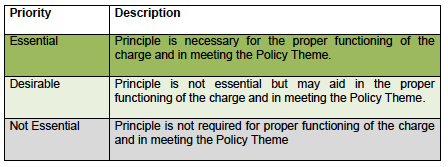
Table 4‑3 Final Priorities
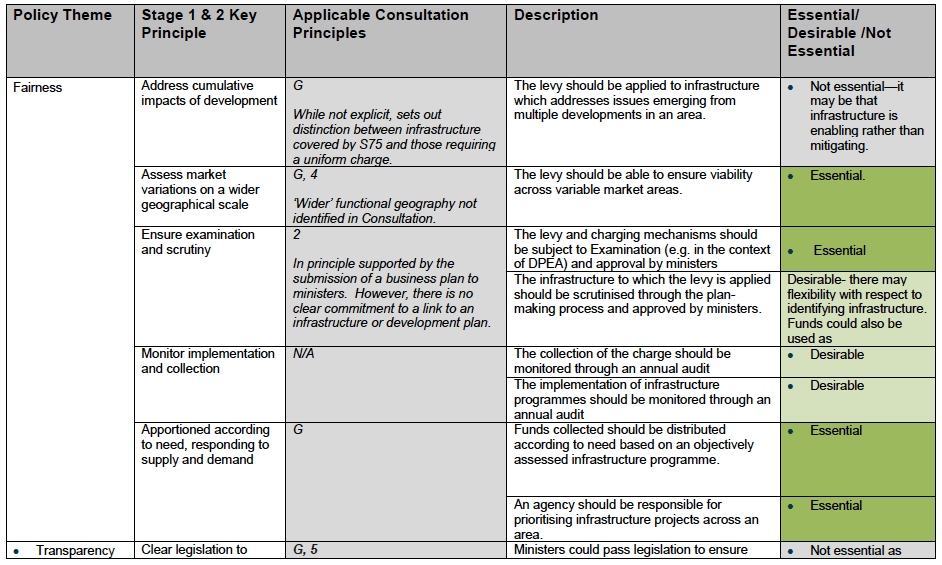
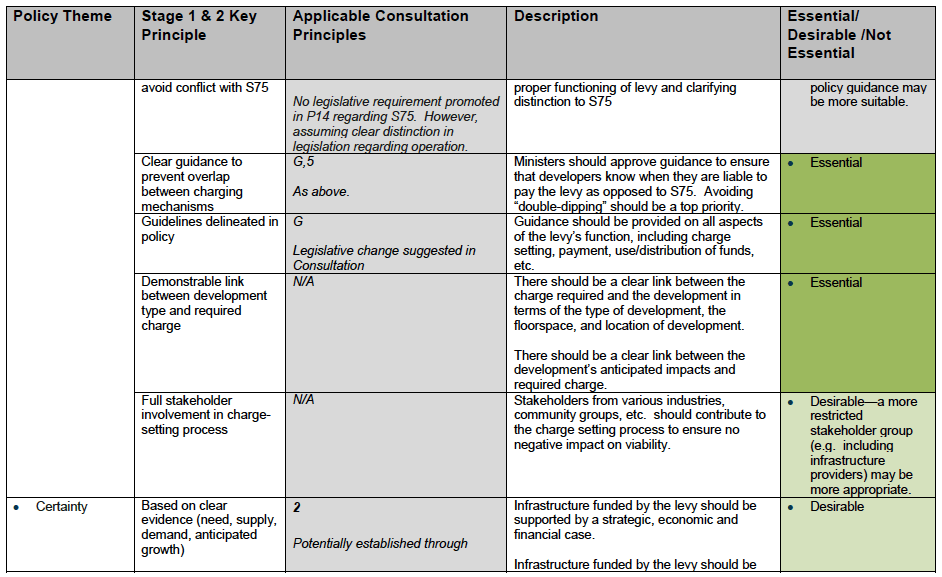
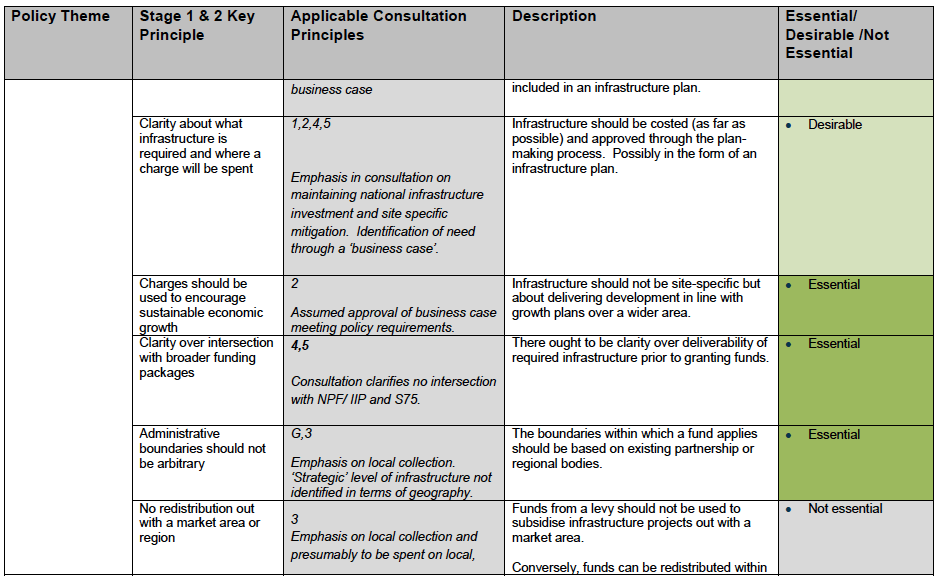
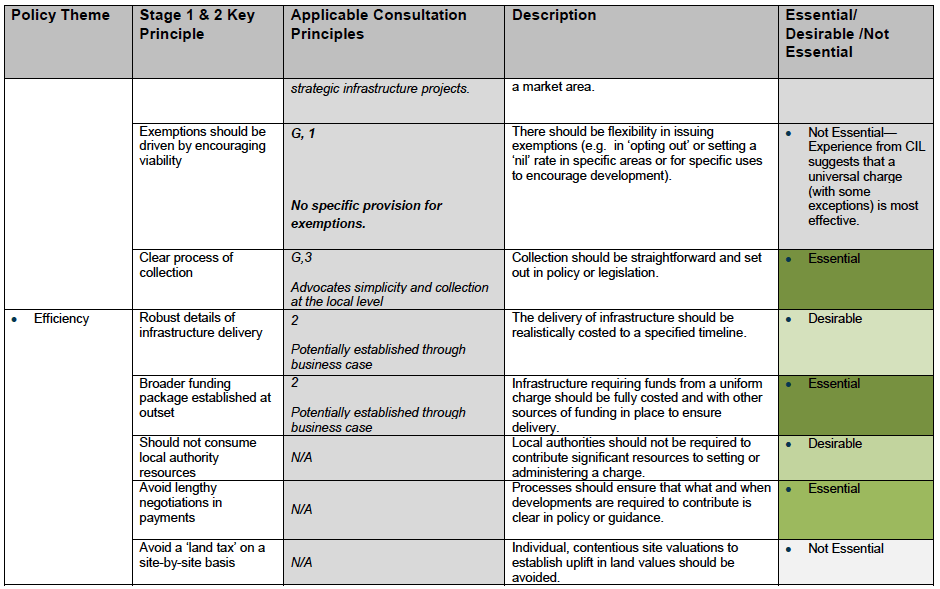
4.6 Central Appraisal Criteria
Setting the Objectives, Outputs and Outcomes
In line with Green Book appraisal methods, a potential charge should be assessed against the proposed objectives, outputs and outcomes.
Objectives and outcomes have been established through Stage 1 and Stage 2 research and subsequent consultations. These are set out as the Key Principles and are central to assessing whether a shortlisted option meets the strategic priorities identified in Stage 1 and Stage 2.
The method for appraisal will be assessed in terms of HM Treasury’s Green Book Appraisal Methods. This guide advocates several components in the appraisal process to ensure comprehensive and proportionate assessment. The assessment is not a full ‘Green Book’ Appraisal but uses the guidance as a starting point for effectively considering, albeit qualitatively, that options have been effectively assessed and that the options themselves are robust. This assessment will include the following assessment areas:
- Options Assessment;
- Shortlisting;
- Cost and Value Estimation;
- Adjustments; and
- Accounting for Risk and Uncertainty.
These assessment areas are covered in detail below, with associated impacts considered in Section 6.
Options Assessment & Shortlisting
This assessment will consider two scenarios derived from an Infrastructure Growth Contribution ( IGC) Model, that is, a ‘Central Co-ordinated Option and a Local Co-Ordinated Option.
These options are to be considered in terms of their practicality with respect to resource efficiency, potential for legal change, impact on viability, value for money, and ability to deliver strategic infrastructure.
In effect, Stage 1 and Stage 2 research provided an initial shortlisting exercise. The scope of the charge is further delineated in section 5.2 of this report.
The Shortlisted Options are therefore assessed according to the criteria developed and refined, as defined in Table 4.3.
Cost and Value Estimation
Costs
Appraisals should consider the relevant opportunity cost associated with action and inaction with respect to policy and legislative change. This appraisal in light of the Central Assessment Criteria does not consider the monetised costs in terms of the implementation and design of the charge as this depends on the governance and administrative arrangements and division of labour in charge setting, collection and more. It may also incorporate existing structures and processes (e.g. planning authorities in plan making or existing agencies) which may reduce the cost of establishing and maintaining a collection system.
Stage 1 and Stage 2 of this research and subsequent consultations have indicated that resource intensive options for charge setting and collection are to be avoided. Scoping out of these options has therefore been completed and it is assumed that these are the Shortlisted Options. Additional issues arising with respect to resources required for roll out, management and administration of the Shortlisted Options are discussed qualitatively.
Stage 3 does not carry out extensive costing analysis.
Broadly speaking, Stage 1 and Stage 2 research set out the following principles with respect to the cost of a charge:
- The ‘cost’ of designing and implementing a charge should be absorbed as much as possible by existing structures and processes;
- There should be little to no additional pressure on local authorities; and
- Efficiencies ought to be achieved through joint working, establishing best practice, clear guidance, and centralised processes where possible etc.
Value
Green Book appraisal methods suggest that the purpose of valuing benefits is to consider whether an option’s benefits are worth its costs, and to allow alternative options to be systematically compared in terms of their net benefits or net costs. Estimating the ‘value’ of the charge should be based on measurable and quantifiable impacts and drawn from market data or other relevant and authoritative sources.
Assessing the impact of the charge is expressed in terms of the receipts generated from a charge according to the specific formula applied to the mechanism and modelled with reference to observed market data, with respect to anticipated developer rates of return and land values. The proposed formula underlying the mechanism is tested based on observed trends and making key assumptions, so as to broadly understand the relationship between the Gross Development Value ( GDV), Residual Land Value ( RLV), and the proposed Infrastructure Growth Contribution ( IGC) mechanism. As such, this assumes that the impacts are measurable and quantifiable (e.g. based on projected house building, delivery of employment floorspace) and at a price or proportion of total costs which are not anticipated to affect viability.
The determination of a formula for assessing potential monetary values associated with the charge is consistent with the above principles, and specifically makes the following assumptions [7] :
- That all development types contribute according to scale (square metres) or outturn values ( GDV), or both, on a consistent basis to avoid market distortions;
- That the amount varies, or has a lower threshold by type or size, or outturn value, to minimise the effect on viability of development;
- That for value based methods the difference between outturn values and development costs is highly variable (the small difference between two larger amounts that themselves are variable) but in general this residual amount increases, non-linearly, with outturn value;
- And that for value based methods, the residual amount should be sufficient to cover existing land use values plus compensation, market expectations, and a premium so that it is worthwhile to the land owner to sell for development;
- That the obligation to provide affordable housing plots at no cost for a minimum of 25% of the dwellings within all developments over the threshold size, as determined in Supplementary Guidance, is universally applied; and
- That other planning obligations will be adjusted scheme by scheme (within the range of acceptable planning outcomes) to ensure scheme viability whilst Infrastructure Growth Contribution remains pre-determined on outturn values.
The extent to which the total value of this contribution meets infrastructure costs is out with the scope of this Study. However, it would be feasible to suggest that:
- The total value expected of the charge should significantly outweigh the cost of implementation;
- The value of the charge should be maximized without impacting development viability; and
- Receipts from the charge should impact wider geographical areas (that is, not site-specific).
Adjustments to Costs and Benefits
There is potential for changes to policy to impact different peoples, groups and geographies. Distributional analysis could be undertaken based on varying market areas, and based on an analysis of impact on stakeholders (e.g. developers). The impact of geography and concomitant market variations should be taken into account in identifying the costs and value/benefits of the scheme.
This analysis is built into the scenario modelling to account for the impact of low-market areas and potential impacts on viability on the ability to pay a charge. As noted, high level options already assume a charge that applies to most developments, though there are concerns about viability.
As noted in the previous sub-section, the analysis ‘builds in’ thresholds associated in terms of ‘flat rate’ and ‘non-linear’ rates to account for non-payment by low value developments. It also considers where charges may disproportionately affect some developments over others (e.g. where a charge is regressive, in the case of flat rates).
It is therefore essential that:
- There should be clear consideration of viability in the formulation of the mechanism;
- There should be oversight in the final development and application of the formula to ensure it is robust; and
- Impacts of inflation should be considered in charge setting (i.e. through a centralised formula).
Risk and Uncertainty
An appraisal of relevant options should consider the inherent risks involved in making decisions in public policy. It is commonplace for benefits to be overstated. There will therefore be adjustments in the assumptions and methodologies to account for bias.
It should be noted that there are certain areas of risk and bias (e.g. delay in receipt of benefits) which cannot be assessed with accuracy due to the highly contingent nature of development and infrastructure delivery.
However, the shortlisted options have been assessed against their potential to identify and mitigate risk and to “minimise the likelihood of their materialising with adverse effects”. The successful management of risk is therefore covered qualitatively.
It is recognised similarly that estimating future receipts of a charging mechanisms may be open to spurious accuracy. This may present overconfidence in the costs/benefits of the scheme, but this assessment of options should moreover consider how the value of the scheme may change due to changing macro-economic conditions, partnership arrangements, and more.
- Contingencies (such as delayed receipts, changing partnership arrangements, etc.) should be accounted for;
- The preferred mechanism should demonstrate impact in ‘low’ scenarios, i.e. where there is limited development and limited receipts; and
- The mechanism should demonstrate incentive for uptake by local authorities or a combination of local authorities.
Future Considerations
There are further steps required before the implementation of a charge which are beyond the scope of this Report. The progression of an infrastructure charging mechanism will require significant collaboration between stakeholders, clear goal setting in line with strategic needs, and prioritisation of infrastructure requirements. Progress against expected infrastructure delivery and the ‘value’ added by the charge will require additional criteria to ensure maximisation of benefits and timely realisation of infrastructure projects. It is recommended that actions following this Report should therefore include:
- Full development of a charge in consultation with key stakeholders;
- Assessing clear project management, performance and measurement;
- Develop criteria for ‘benefits realisation’ in line with anticipated receipts, anticipated allocation to infrastructure projects and indirect impacts (qualitative and quantitative); and
- Create evaluation framework: define more specific objectives based on regional/local needs, set target, and ensure collection and implementation of monitoring data.
Contact
There is a problem
Thanks for your feedback